Art & Exhibitions
Eungie Joo’s Cautious Sharjah Biennial Fails to Engage With Reality
A strong list of artists simply isn't enough.
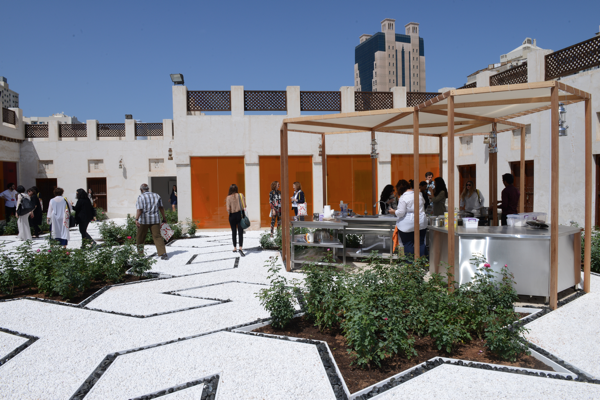
A strong list of artists simply isn't enough.

Coline Milliard

With biennials continuing to proliferate (see Vienna Gets Its Own Biennial), it might be time to stop and ask: how is their success to be measured? Surely, the quality of the art on show is only part of the answer here. While it is probably difficult to find a wonderful, thought-provoking biennial exclusively filled with poor art, the reverse isn’t unusual. Enlisting a string of good artists simply isn’t enough. Something else has to happen: not necessarily the servicing of a grand curatorial concept—bearing in mind all the problems these often entail—but at least the establishment of a network of resonances between the works, a sense that what they add up to is more than the sum of their parts.
This is where the 12th Sharjah Biennial falls short. With “The Past, the Present, the Possible,” curator Eungie Joo promises simultaneously “a meditative pause to reassert the need for wonder” and a reflection on Sharjah’s “ambitions, possibilities, and being.” Spread over a slew of venues by the harbor, the biennial achieves little of the former and almost none of the latter. This is regrettable, particularly considering Sharjah’s cultural cachet as a beacon of intellectual rigor in the Middle East, and the critical acclaim garnered by some of the previous editions—most recently, by the 11th biennial curated by Yuko Hasegawa.
It’s not as if there is not much to talk about. But many subjects associated with the UAE’s past and present—the value of labor, human and women’s rights, or the stronghold of religion on all aspects of civil life—are simply not to be discussed. As anyone who works in the region knows, one has to play by the rules or not at all. Sharjah ruler Sheikh Sultan bin Mohammed al-Qasimi made this abundantly clear a couple of editions ago, when he sacked Jack Persekian—the long-standing artistic director of the Sharjah Art Foundation, widely credited for the biennial’s curatorial kudos—for failing to censor an installation by Algerian artist Mustapha Benfodil deemed “blasphemous.”
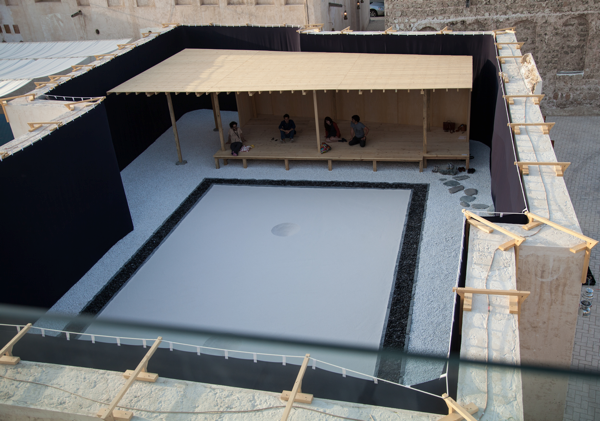
Taro Shinoda, Karesansui, 2015
Image courtesy of Sharjah Art Foundation
Photo by Deema Shahin
In such a context, there’s only one way to play it: safe. That’s perhaps where Joo’s “meditative pause” comes in. Several international heavyweights invited to respond to Sharjah for this 12th edition have focused on the UAE’s most trivial aspects: dunes, exotic animals, a Thousand and One Nights’ fragrances. That’s not just rhetorical. “Struck by an encounter with the desert,” Japanese artist Taro Shinoda made a Zen garden with Emirati sand. Abraham Cruzvillegas provided a new perch for the tamed birds of prey he encountered at the local market. The imagination of Relational Aesthetics poster boy Rirkrit Tiravanija was fired by a rosewater distillery he saw at Sharjah’s Museum of Islamic Civilizations. He commissioned a replica, and built an entire “relational” installation around it, complete with Arabic rose garden, chefs to cook rosewater-based delicacies, and comfy ottomans to consume them on. The ensemble is as pleasant as it is inoffensive.
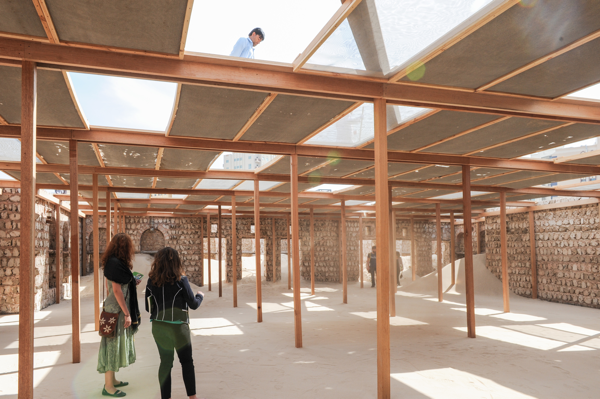
Cinthia Marcelle, At The Risk of The Real, 2015
Image courtesy of Sharjah Art Foundation
Photo by Alfredo Rubio
Only Cinthia Marcelle dared to push the envelope, with a subtle installation that is perhaps the most successful commission of this entire edition. Set in one of the spaces located in maze-like Sharjah Heritage Area, At The Risk of the Real (2015) resembles a semi-derelict house, eaten away by the sand. Above, there is no roof, only large squares of mesh suspended between planks. Men dressed as laborers occasionally step on them, shaking off sand that lands in the eyes of the visitors. This temporarily blinds them to the uncomfortable vision of these men toiling in the heat, like on so many building sites around the emirate.
Most of the artists featured have stuck to what they do well. These are more safe options, which produced solid and enjoyable—if familiar—solo presentations, often displayed in their own independent space. Joo’s long-time collaborator Danh Vo has come up with yet another of his gigantic Statue of Liberty morsels; painter Lynette Yiadom-Boakye continues with her series of fictional portraits. There’s an extensive selection of paintings by a much feted “re-discovery”: the 90-year-old Lebanese poet and painter Etel Adnan, whose semi-abstract landscapes have become something of an institutional staple of late.
Yet sometimes it’s not the existing bodies of work that provide much-needed grit: Basel Abbas and Ruanne Abou-Rahme’s multi-channel installation The Incidental Insurgents (2012-15) is a biennial favorite, having been shown at the Istanbul Biennial in 2013, and the São Paulo and Gwangju Biennials last year. The Sharjah Biennial commissioned the third part, When the fall of the dictionary leaves all words lying in the streets, which is presented here alongside part 1 and 2. Bathed in a tense electronic soundtrack, the immersive piece pictures the duo in an unhinged road trip in Palestine, as snippets of sentences like “to be anonymous, to reappear as another figure, to have many returns” crop up on the screens alongside allusions to insurgents of all stripes.
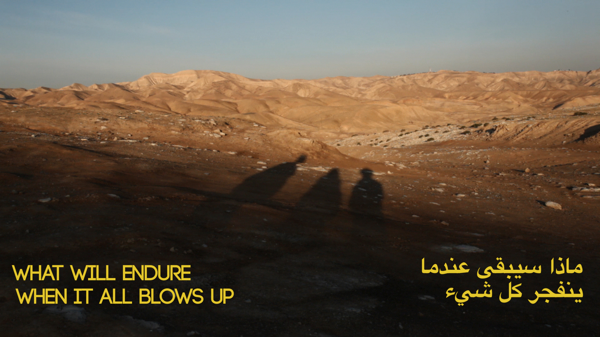
Basel Abbas and Ruanne Abou-Rahme, The Incidental Insurgents: When the fall of the dictionary leaves all words lying in the streets (Part 3), 2015
Video still. Courtesy of the artists.
While somewhat elusive, The Incidental Insurgents has a real sense of urgency. It points to the role of individual responsibility in a conflict environment, and the new modes of self-organizations that emerged in the successive waves of protests and revolutions of the last few years. These are grounded by the archive-cum-installation presented in another room. The myriad of photographs, notebooks, and cuttings accumulated on and around a desk conjures up an intellectual blueprint of dissent, anchored in the past to trace a roadmap for the struggles, both present and yet to come.
Elsewhere, the 1970s brightly painted sawdust-and-glue reliefs by former PLO member Abdul Hay Mosallam Zarara haven’t lost any of their poignancy. Depicting scenes ranging from the everyday to the symbolic—but often featuring guns and keffiyeh—these are an uncomfortable reminder of how little things have changed, or, indeed how much worse they’ve become.
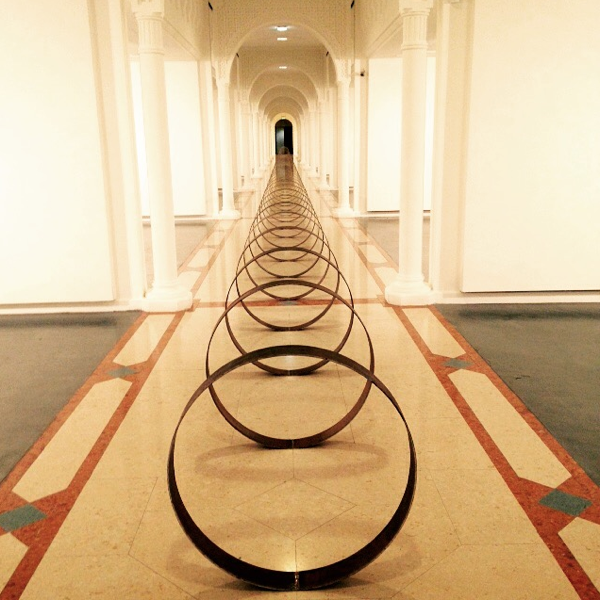
Rayyane Tabet, Steel Rings 2013-ongoing
Photo: Coline Milliard
Rayyane Tabet also deserves a special mention. His monumental Steel Ring (2013) installed at the Sharjah Art Museum, is both formally elegant and conceptually strong. The line of steel rings replicates a section of the pipe built in 1948 to transport oil from Saudi Arabia to Lebanon, and across Jordan and Syria. Each ring is engraved with its geographical coordinates, thus tracing an arc of conflict in the terrain it covers, from the Six-Day War to the Syrian Civil War.
But these exciting pieces are exceptions in an otherwise tepid and disjointed offering. And they are too few and far between to make this 12th edition a success.